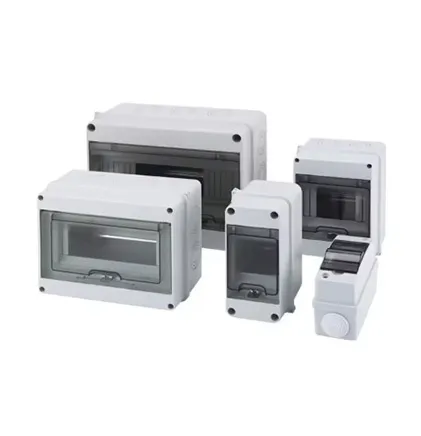
RoHS and REACH Compliance for Environmentally Friendly Distribution Box Components

The Green Revolution in Electrical Engineering
Picture walking through a lush forest, breathing clean air while the electrical infrastructure around you hums quietly, safe in the knowledge that every component in that distribution box nearby was created without harming our planet. That's the promise of RoHS and REACH compliance in electrical engineering.
These regulations aren't just red tape—they're guardians of our ecological future. When we design distribution boxes and electrical enclosures with RoHS and REACH standards at their core, we're not just meeting legal requirements; we're honoring an unspoken promise to future generations. It transforms cold metal boxes into silent environmental stewards that sit at the heart of our power grids.
Beyond the Acronyms: Understanding What RoHS & REACH Actually Mean
RoHS feels personal to me because it started as protection against industrial toxins—a human story dressed as regulation. Born from mounting evidence about lead poisoning in electronics waste, the Restriction of Hazardous Substances Directive has been pulling toxic chemicals out of our lives since 2003. Cadmium, mercury, hexavalent chromium—these aren't just obscure chemical names but hidden risks that once lurked inside distribution boxes.
Meanwhile, REACH acts like a chemical detective novel playing out across industrial landscapes. Registration, Evaluation, Authorisation—the three pillars build a system where every chemical substance must step into the spotlight before entering our manufacturing streams. For a humble distribution box, this means the steel casing, plastic insulation, and even painting pigments undergo rigorous safety scrutiny.
Their partnership forms a powerful environmental pact: RoHS shields us from known toxins, while REACH anticipates unknown risks before they ever reach production lines. This dynamic duo has redefined what "safety" means beyond electrical function to include environmental harmony.
The Ripple Effect: How Compliance Transforms Supply Chains
Supply chains breathe like living organisms rather than rigid systems. Distributors become storytellers who can trace a component's journey backward to its mineral origins. That aluminum casing? We'll know if its bauxite was mined sustainably. The copper wiring? Trackable down to the smelter's emissions controls.
Consider a procurement manager selecting thermoplastic components. RoHS compliance transforms that choice from technical specs to human impact—will this insulator quietly leach brominated flame retardants into groundwater decades from now? Such considerations turn sourcing into a moral dialogue with future generations.
Incorporating sustainable solutions like green and environmentally friendly building materials fundamentally changes how we approach enclosure manufacturing.
Beyond Compliance: When Environmental Commitment Becomes Competitive Advantage
The best manufacturers develop a palpable environmental intuition. They sense opportunities where others see obligations. Consider how forward-thinking engineers now experiment with:
- Biopolymers made from agricultural waste for enclosure bodies
- Electrodeposited coatings that replace toxic chromates
- Flame-retardant additives derived from seaweed compounds
These innovations transform distribution boxes from passive containers into environmental statements. An enclosure using recycled ocean plastic doesn't just house equipment—it embodies corporate responsibility that resonates with end consumers on a visceral level.
This shift reaches beyond economics into brand mythology. Companies find customers develop loyalty to their distribution boxes—the way people cherish vintage electronics but with an eco-conscious twist.
Navigating the Practical Landscape: Hands-On Guidance
The daily reality of compliance thrives in details most engineers overlook. For distribution box component manufacturers, the essential toolkit includes:
The Chemistry Detective Kit: XRF guns that reveal elemental secrets of materials, lab-grade solvent tests that hunt down prohibited stabilizers, gas chromatographs that sniff out hidden phthalates.
Paper Trails That Feel Alive: Certificates of Compliance shouldn't be static documents but living histories that evolve with each component batch—digital threads connecting raw materials to finished enclosures.
Red Team Thinking: Regular "compliance crisis simulations" where you intentionally try to sneak non-compliant materials through your system, stress-testing safeguards.
The Unseen Heroes: Distribution Boxes as Environmental Guardians
Imagine distribution boxes serving as silent environmental watchdogs within our energy infrastructure. Every insulator, breaker, and chassis screw selected through RoHS/REACH lenses creates cumulative impact:
- Lead-free solder prevents 300 tons of neurotoxins from entering European landfills annually
- REACH's SVHC tracking has eliminated 80+ hazardous substances before they reached mass production
- Compliant enclosures reduce toxic leachate when eventually recycled
The real magic surfaces during decommissioning. I've witnessed trained maintenance crews disassembling RoHS-compliant distribution boxes with the same care as archaeology teams handling artifacts—each component cleanly sorted for remanufacturing rather than crude shredding.
The Living Road Ahead: Compliance as Evolution
RoHS didn't stop evolving in 2011 when it became Recast. Just last year, four novel phthalates joined its restricted list, proving that compliance isn't a destination but perpetual journey. Similarly, REACH constantly unveils new substances for authorization.
The wisest manufacturers anticipate rather than react. They cultivate relationships with research chemists exploring tomorrow's green alternatives. One distribution box producer I admire maintains a "Future Substances Watchlist" updated quarterly through university partnerships.
This mindset transforms regulatory challenges into wellsprings of innovation. When EU regulators flagged internal cabling with perfluorinated compounds, visionary companies didn't just substitute them—they reimagined connection systems entirely, emerging with modular contact blocks that reduced wiring needs by 40%.
The final enclosure resting at power stations and factory floors represents this spirit—not just compliant but consciously regenerative to support both modern infrastructure and ecological restoration efforts simultaneously.
Tags:
Recommend Products











